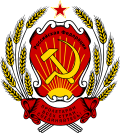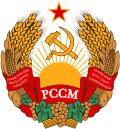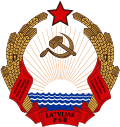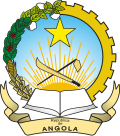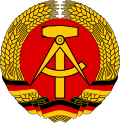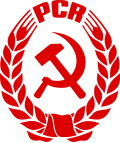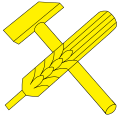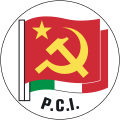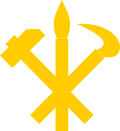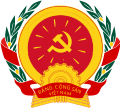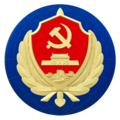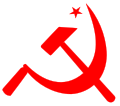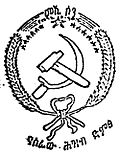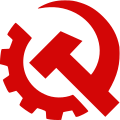Hammer and sickle

The hammer and sickle (
After
History
Worker symbolism
One example of use prior to its political instrumentalization by the Soviet Union is found in Chilean currency circulating since 1894.[2][3]
Inception
In 1918,
In 1919, the new Republic of Austria introduced a sickle and a hammer to its coat of arms, one in each talon of its supporting eagle, to represent the farming and industrial classes. They were removed in 1934 with the establishment of the Fascist Federal State of Austria and returned in 1945 after the defeat of Nazi Germany (which had absorbed Austria in 1938) in the Second World War.
In his work, Daily Life in a Crumbling Empire: The Absorption of Russia into the World Economy, sociologist David Lempert hypothesizes that the hammer and sickle was a secular replacement for the patriarchal cross.[8][9]
Use in Soviet Union


- The uniform and in many other places.
- Serp i Molot (transliteration of Russian: cерп и молот, "sickle and hammer") is the name of the Moscow Metallurgical Plant.
- Serp i Molot is also the name of a stop on the .
Meaning
At the time of creation, the hammer and sickle stood for worker-peasant alliance, with the hammer a traditional symbol of the industrial proletariat (who dominated the proletariat of Russia) and the sickle a traditional symbol for the peasantry, but the meaning has since broadened to a globally recognizable symbol for Marxism, communist parties, or socialist states.[6]
Current usage
Post-Soviet states
Two federal subjects of the post-Soviet Russian Federation use the hammer and sickle in their symbols: the Vladimir Oblast has them on its flag and the Bryansk Oblast has them on its flag and coat of arms, which is also the central element of its flag. In addition, the Russian city of Oryol also uses the hammer and sickle on its flag.[10]
The former Soviet (now Russian) national airline, Aeroflot, continues to use the hammer and sickle in its symbol.[11]

The de facto government of
Communist parties
Three out of the five currently ruling Communist parties use a hammer and sickle as the party symbol: the Chinese Communist Party, the Communist Party of Vietnam and the Lao People's Revolutionary Party. In Laos and Vietnam, the hammer and sickle party flags can often be seen flying side by side with their respective national flags.[citation needed]
Many communist parties around the world also use it, including the
Variations

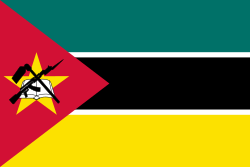
Many symbols having similar structures and messages to the original have been designed. For example, the Angolan flag shows a segment of a cog, crossed by a machete and crowned with a socialist star, while the flag of Mozambique features an AKM crossed by a hoe. In the logo of the Communist Party USA, a circle is formed by a half cog and a semicircular sickle-blade. A hammer is laid directly over the sickle's handle, with the hammer's head at the logo's center. The logo of the Communist Party of Turkey consists of half a cog wheel crossed by a hammer, with a star on the top.[15]
Tools represented in other designs include: the
The
In 1938, the
The flag of Chama Cha Mapinduzi (CCM, Party of the Revolution in Swahili), currently the ruling political party of Tanzania, has a slightly different symbol with a hammer and a hoe (jembe) instead of a sickle to represent the most common farm tool in Africa.[citation needed]
The symbols of the
The election symbol of the Communist Party of India consists of a horizontal sickle, vertically crossed by Ears of Corn in the center.
Art
The hammer and sickle has long been a common theme in socialist realism, but it has also seen some depiction in non-Marxist popular culture. Andy Warhol who created many drawings and photographs of the hammer and sickle is the most famous example of this.
-
The metro station, Plošča Lienina, Minsk
-
Sándor Pinczehelyi, Hammer and Sickle
-
The Hoof and Horn flag described in the book Animal Farm is a parody of the hammer and sickle.
Legal status
In several countries in the former
In 2010, the Lithuanian, Latvian, Bulgarian, Hungarian, Romanian, and Czech governments called for the European Union to criminalize "the approval, denial or belittling of communist crimes" similar to how a number of EU member states have banned Holocaust denial. The European Commission turned down this request, finding after a study that the criteria for EU-wide criminal legislation were not met, leaving individual member states to determine the extent to which they wished to handle past totalitarian crimes.[31]
In February 2013, the
In
In Poland, dissemination of items which are "media of fascist, communist or other totalitarian symbolism" was criminalized in 1997. However, the Constitutional Tribunal found this sanction to be unconstitutional in 2011.[38]
Usage gallery
Flags
Europe and Russia/Soviet Union
Current
-
Flag of the Communist Party of the Russian Federation
-
Flag of the Communists of Russia
-
Flag of the United Communist Party (Russia)
-
Flag of the SERB (Russia)
-
Flag of Bryansk Oblast (Russia)
-
Flag of Vladimir Oblast (Russia)
-
Flag of Oryol (Russia)
-
Flag of Dzerzhinsk (Russia)
-
Flag of Transnistria (Moldova)
-
Flag of the Communist Party of Greece
-
Flag of the Communist Refoundation Party (Italy)
-
Flag of the Communist Party of Ireland
-
Flag of the Portuguese Communist Party
-
Flag of the Maoist Communist Party (Turkey)
-
Flag of theRevolutionary People's Liberation Party–Front (Turkey)
-
Flag of the Communist Party of Britain
Former
-
Flag of the Soviet Union from 1922 to November 1923
-
Flag of the Soviet Union from November 1923 to April 1924
-
Flag of the Soviet Union from April 1924 to December 1936
-
Flag of the Soviet Union from December 1936 to 1955
-
Flag of the Soviet Union from 19 August 1955 to 26 December 1991
-
Naval Jack of the Soviet Union and Russia from 16 November 1950 to 26 July 1992
-
Naval ensign of the Soviet Union and Russia from 16 November 1950 to 26 July 1992
-
Flag of Aeroflot from 1961 to 1991
-
Flag of theRussian SFSRfrom 1954 to 1991
-
Flag of theUkrainian SSRfrom 1950 to 1992
-
Flag of theByelorussian SSRfrom 1951 to 1991
-
Flag of theUzbek SSRfrom 1952 to 1991
-
Flag of theKazakh SSRfrom 1953 to 1992
-
Flag of theGeorgian SSRfrom 1951 to 1990
-
Flag of theAzerbaijani SSRfrom 1956 to 1991
-
Flag of theLithuanian SSRfrom 1953 to 1988
-
Flag of theMoldavian SSRfrom 1952 to 1990
-
Flag of theLatvian SSRfrom 1953 to 1990
-
Flag of theKirghiz SSRfrom 1952 to 1992
-
Flag of theTajik SSRfrom 1953 to 1991
-
Flag of theArmenian SSRfrom 1952 to 1990
-
Flag of theTurkmen SSRfrom 1953 to 1992
-
Flag of theEstonian SSRfrom 1953 to 1990
-
Flag of theKarelo-Finnish SSRfrom 1953 to 1956
-
Flag of the Communist Party of the Donetsk People's Republic
-
Flag of the Decommunization (Russia)
-
Flag of the Romanian Communist Party
-
Flag of the National Bolshevik Party
-
Flag of the Communist Party of Germany
-
Reverse side of the Communist Party of Germany flag
-
Flag of East Germany from 1959 to 1990
-
Flag of the Italian Communist Party
-
Flag of the Sammarinese Communist Party
-
Flag of the League of Communists of Yugoslavia
Asia minus Russia/Soviet Union
Current
-
Flag of the Vietnamese Communist Party
-
Flag of the Chinese Communist Party
-
Flag of the Taiwan People's Communist Party
-
Flag of the Workers' Party of Korea
-
Flag of the Communist Party of India
-
Flag of the Communist Party of India (Marxist)
-
Flag of various South Asian communist parties, including the Communist Party of India (Maoist)
-
Flag of theSocialist Unity Centre of India
-
Flag of the Communist Party of Bangladesh
-
Flag of the Socialist Party of Timor
-
Flag of the Communist Party of the Philippines
-
Flag of the Lao People's Revolutionary Party
-
Flag of the Lebanese Communist Party
-
Flag of the Syrian Communist Party (Bakdash)
-
Flag of the Jordanian Communist Party
-
Flag of thePalestinian Communist Party
Former
-
Flag of the Chinese Communist Party (before 1996)
-
Flag ofChinese Workers' and Peasants' Red Army
-
Flag of the Taiwan Democratic Communist Party
-
Flag of the Chinese Soviet Republic (1931–1937)
-
Flag of various South Asian communist parties, including the Communist Party of India (Maoist)
-
Flag of the Communist Mazdoor Kissan Party
-
Flag of the Nepal Communist Party
-
Flag of Communist Party of Indonesia
-
Flag of the Communist Party of Kampuchea
-
Flag of the Malayan Communist Party (1930–1989)
-
Flag of the Kurdistan Workers' Party (1978–1995)
Africa
Current
-
Flag of the Communist Party of Kenya
-
Flag of the South African Communist Party
-
Flag of the Communist Party Marxist – Kenya
-
Flag of the Communist Party of Swaziland
-
Flag of the People's Republic of the Congo and the Congolese Party of Labour
Former
-
Flag of the Algerian Communist Party
-
Flag of FRELIMO (1987–2004)
-
Flag of the Workers' Party of Ethiopia
Americas
Current
-
Flag of the PCCE
-
Flag of the PCB
-
Flag of the PCdoB
-
Flag of the Workers' Cause Party (Brazil)
-
Flag of the Communist Party of Chile
-
Flag of the Communist Party of Ecuador
-
Flag of the Shining Path (Peru)
-
Flag of the Communist Party USA
-
Flag of the Revolutionary Communist Party (Argentina)
State emblems
Soviet Union (in the constitutional order)
-
Emblem of the Russian Soviet Federative Socialist Republic
-
Russian Federation(1992‒1993)
Other
Current
-
Emblem of the self-proclaimed Pridnestrovian Moldavian Republic
-
Coat of arms of Bryansk Oblast, Russia
Former
-
German Democratic Republic(1955–1990)
-
State emblem of the Tuvan People's Republic(1943‒1944)
-
State emblem of the Lao People's Democratic Republic (1975‒1991)
-
Emblem of the People's Republic of the Congo (1970–1991)
-
State emblem of the Chinese Soviet Republic(1934–1937)
-
Emblem of Hungarian People's Republic (1949–1956)
-
Emblem of Moscow (1924–1937)
Logos
Europe
Current
-
Logo of the Communist Party of the Russian Federation
-
Logo of the Communist Party of Greece
-
Logo of the Communist Party (Italy)
-
Logo of the Communist Party of Spain
-
Logo of the Portuguese Communist Party
-
Logo of the Communist Party of Ireland
-
Logo of the Communist Party of Britain
-
Logo of the Communist Party (Sweden)
-
The Logo of the Communist Party of Norway
-
Logo of the Communist Party of Denmark
-
Logo of the Communist Party (Denmark)
-
Logo of the Communist Party (Switzerland)
-
Logo of the New Communist Party of the Netherlands
-
Logo of the Communist Party of Belgium (1989)
-
Badge of the Marxist–Leninist Communist Party of Turkey
-
Logo of the Revolutionary Communist Party of Turkey
-
Logo of Aeroflot
Former
-
The hammer and sickle symbol used with the red star used as a symbol of Soviet Union.
-
Badge of the Communist Party of the Soviet Union
-
Emblem of the Communist Party of Czechoslovakia
-
Emblem of the Romanian Communist Party
-
Logo of the Bulgarian Communist Party
-
Compass and hammer of East Germany.
-
Hammer and grain of the Hungarian People's Republic
-
Emblem of the League of Communists of Yugoslavia
-
Logo of the Italian Communist Party
-
Logo of the Proletarian Unity Party (Italy)
-
Logo of the Communist Party of the Peoples of Spain
-
Logo of the French Communist Party (1980‒1996)
-
Logo of the Communist Party of Germany
-
Logo of the Communist Party of Ireland (Marxist–Leninist)
-
Symbol of the Group of Social Revolutionary Nationalists
Asia
Current
-
Emblem of the Workers' Party of Korea
-
Logo of the Communist Party of Tajikistan
-
Logo of the Socialist Party of Bangladesh
-
Emblem of the Communist Party of Vietnam
-
Alternative emblem of the Communist Party of Vietnam
-
Logo of the Ministry of State Security
-
Emblem of the Chinese Communist Party (1996–present)
-
Logo of the Lanka Sama Samaja Party, which features the symbol of the Fourth International
-
Logo of the Communist Party of India
-
Logo of the Communist Party of India (Marxist)
Former
-
Emblem of the Communist Party of Indonesia (1914‒1966)
-
Logo of the Acoma Party (Indonesia)
-
Logo of the Communist Party of Nepal (Unified Marxist–Leninist) (1991–2018)
-
Emblem of the Chinese Communist Party (1942–1996)
-
Emblem of the Yemeni Socialist Party (1978-1990)
Africa
Current
-
Logo of thePeople's Movement for the Liberation of Angola
-
Logo of the Communist Party of Benin
-
Logo of the Congolese Party of Labour
-
Logo of the Egyptian Communist Party
-
Emblem of the All-Ethiopia Socialist Movement
-
Hammer and machete logo of the Revolutionary Communist Party of Ivory Coast
-
Logo of the Communist Party of Kenya
-
Logo of the South African Communist Party
-
Logo of the Workers' Party of Tunisia
Former
-
Flag of the Workers' Party of Ethiopia
-
Emblem of the Ethiopian People's Revolutionary Party (ca. 1975)
-
Logo of FRELIMO (Mozambique) (1987–2004)
-
Emblem of the Somali Revolutionary Socialist Party
-
Logo of the Workers' Party of Tunisia
Americas
Current
-
Logo of the Communist Party of Argentina
-
Logo of the Brazilian Communist Party
-
Logo of the Communist Party of Brazil
-
Logo of the Workers' Cause Party
-
Logo of the Communist Party of Chile
-
Logo of the Communist Party of Ecuador
-
Logo of the Paraguayan Communist Party
-
Logo of the Shining Path
-
Emblem of the Communist Party USA
Former
-
Logo of the Mexican Communist Party
Unicode
In Unicode, the "hammer and sickle" symbol is U+262D (☭). It is part of the Miscellaneous Symbols (2600–26FF) code block. It was added to Unicode 1.1 in 1993.[39]
See also
- Arm and hammer
- Fist and rose
- Communist symbolism
- Socialist heraldry
- Hammer and pick (⚒)
- Red flag (⚑)
- Red star (★)
- Transport and Map Symbols Unicode block (contains 🛠 "hammer and wrench" as U+1F6E0)
Notes
References
- Encyclopedia Britannica. Retrieved 30 November 2019.
- ^ "20 Centavos 1895". Numista. Archived from the original on 22 January 2025.
- ^ "Chilean peso example, 1927". Retrieved 22 January 2025.
- ^ "АртРу.инфо - Художники - Камзолкин Евгений Иванович". Artru.info. 18 March 1957. Archived from the original on 4 March 2016. Retrieved 2 January 2017.
- ^ "International Gallery of Contemporary Artists". Archived from the original on 16 August 2016. Retrieved 6 November 2015.
- ^ a b c Wharton, Christopher. "The Hammer and Sickle: The Role of Symbolism and Rituals in the Russian Revolution". The Myriad: Westminster's Interactive Academic Journal. Archived from the original on 10 August 2014. Retrieved 1 September 2023.
- ISBN 978-0-253-33333-9.
- ISBN 0-880-33341-3.
- ^ Crangan, Costel (1 September 2018). "De unde vine simbolul "secera şi ciocanul". Ce ţară l-a folosit prima şi în ce state este interzis" [Where does the symbol "sickle and hammer" come from? Which country used it first and in which states it is forbidden] (in Romanian). Adevarul Holding.
- ^ "Hammer and Sickle on Flags and State Emblems". Soviet Tours. 13 May 2020. Retrieved 21 April 2025.
- ^ "Aeroflot Logo To Keep Hammer And Sickle". aviationweek.com. 18 April 2003. Retrieved 16 September 2022.
- Marine Corps University Press: 175. Retrieved 21 April 2025.
- ^ "KKE - Αρχική". kke.gr.
- ^ "Estatutos do PCP, art. 72". pcp.pt/estatutos-do-pcp. 17 March 2010.
- ^ TM (17 June 2019). "Turkey's communist party to boycott İstanbul election". Turkish Minute. Retrieved 16 March 2025.
- ^ "Parti Communiste Guadeloupéen". flagspot.net.
- ^ Khin Yi (1988). The Dobama Movement in Burma (1930-1938). Cornell University Press. p. 39.
- ^ မြန်မာဖတ်စာ ဒုတိယတန်း (Grade-3) [Myanmar Textbook for Second Standard (Grade-3)] (in Burmese). Ministry of Education, Government of the Union of Myanmar. 2006. p. 1.
- ^ Communist symbols to be banned in Georgia, BBC News, 4 May 2014, retrieved 13 May 2014
- ^ "Act C of 2012 on the Criminal Code, Section 335: Use of Symbols of Totalitarianism" (PDF). Ministry of Interior of Hungary. p. 97. Retrieved 21 February 2017.
Any person who: a) distributes, b) uses before the public at large, or c) publicly exhibits, the swastika, the insignia of the SS, the arrow cross, the sickle and hammer, the five-pointed red star or any symbol depicting the above so as to breach public peace – specifically in a way to offend the dignity of victims of totalitarian regimes and their right to sanctity – is guilty of a misdemeanor punishable by custodial arrest, insofar as they did not result in a more serious criminal offense.
- ^ Latvia Bans Soviet, Nazi Symbols, RIA Novosti, 21 June 2013, retrieved 14 September 2014
- ^ "Lithuanian ban on Soviet symbols". BBC News. 17 June 2008.
- Radio Free Europe. 12 July 2012.
- ^ "Ukraine Bans Soviet-Era Symbols". The Wall Street Journal.
- ^ LAW OF UKRAINE. On the condemnation of the communist and national socialist (Nazi) regimes, and prohibition of propaganda of their symbols
- ^ "Про засудження комуністичного та націонал-соціалістичного ... - від 09.04.2015 № 317-VIII". rada.gov.ua.
- ^ "Free speech questioned as Estonia prepares to ban Soviet, Nazi symbols".
- ^ "Ants Erm: Erinevalt venelaste ajaloost on Venemaa ajalugu Eestis vaid vägivald, küüditamine ja kommunistlik diktatuur".
- ^ "У поліції нагадали, що за серп і молот можна сісти на 5 років". Українська правда (in Ukrainian). Retrieved 5 July 2022.
- ^ Bobkov, Denys (7 May 2021). "Заборона символіки тоталітарних режимів: що мають знати миколаївці".
- ^ EU won't legislate on communist crimes, BBC News (22 December 2010).
- ^ "Hungary, hammer and sickle ban declared illegal". ANSA. 27 February 2013. Retrieved 12 November 2013.
- ^ "Constitutional Court rules that 'hammer and sickle' can be used". allmoldova.com. 5 June 2013. Archived from the original on 12 November 2013. Retrieved 12 November 2013.
- ^ "Declassified files outline US support for 1965 Indonesia massacre". archive.is. 29 October 2017. Archived from the original on 29 October 2017. Retrieved 16 February 2019.
- ^ Dickie Christanto (20 October 2008). "Artists summoned over communist symbol exhibition". The Jakarta Post. Archived from the original on 26 October 2008. Retrieved 12 November 2013.
- ^ "Indonesian activist jailed for advocating communism". ucanews.com. Retrieved 16 February 2019.
- ^ "Indonesia's 'Anti-Communism' Law Used Against Environmental Activist". Human Rights Watch. 12 January 2018. Retrieved 21 July 2021.
- ^ "Nowelizacja kodeksu karnego" (in Polish). 19 July 2011. Retrieved 8 April 2015.
- ^ "☭ Hammer and Sickle Emoji". emojipedia.org. Retrieved 11 October 2019.
External links
 Media related to Hammer and sickle at Wikimedia Commons
Media related to Hammer and sickle at Wikimedia Commons Media related to Hammer and sickle in heraldry at Wikimedia Commons
Media related to Hammer and sickle in heraldry at Wikimedia Commons








































































































